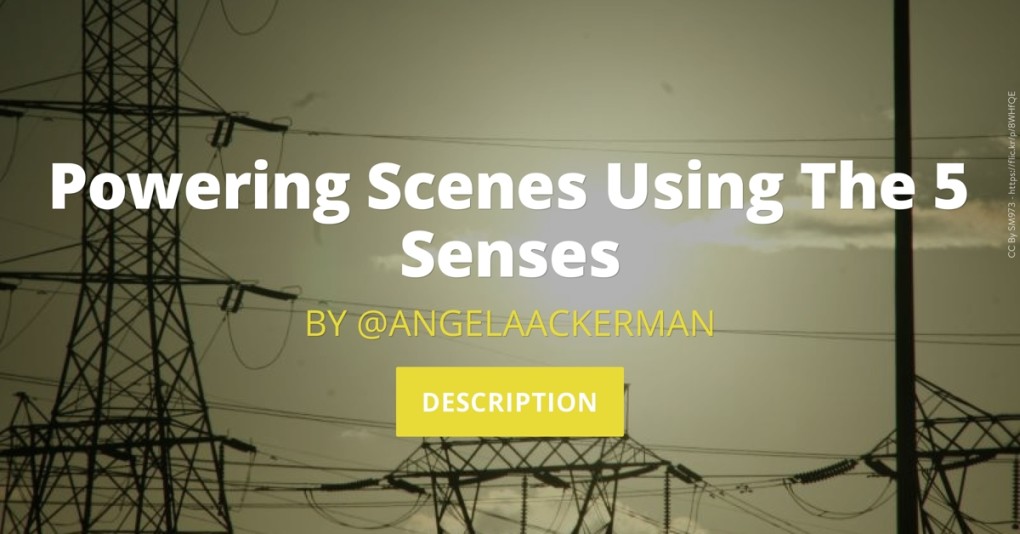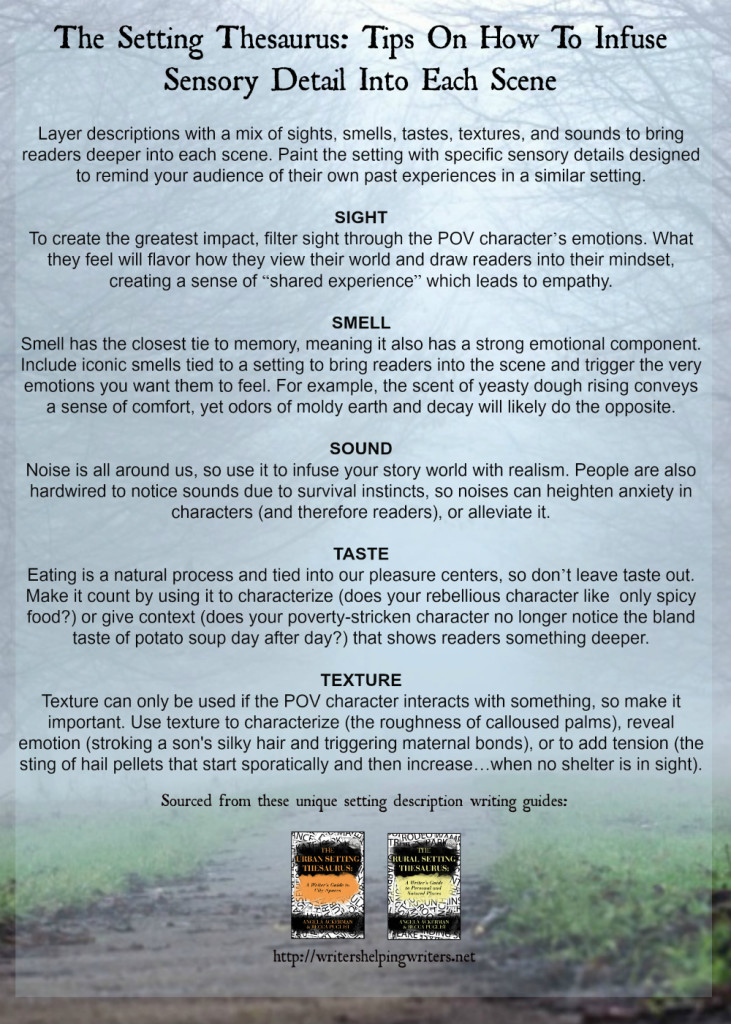by Angela Ackerman, @AngelaAckerman
There isn’t a writer alive who doesn’t believe description is important. We know that the key to pulling readers into our fictional world lies in how well we can describe each scene, giving it color and texture, and infusing it with emotion and substance. And one of the very best ways to achieve this is to use sensory detail: the sights, smells, tastes, textures, and sounds that our POV character or narrator experiences.
Emotion factors heavily in sensory description because the mindset of the POV character influences what they notice (which also determines what details the reader is privy to). A character sitting by a river to enjoy a happy, reflective moment after graduating university may be drawn to clusters of green shoots along the muddy bank that slant in the direction of the sun. She might note the sharp, clean scent of pine needles and how each breath makes her feel renewed. The give of moss, the gentle breeze, and the sound of the water chuckling across stones…all of these details may lull her (and the reader) into a sleepy state of satisfied bliss.
However, a character dropping behind an uprooted tree along the riverbank to hide from her enemies would focus on different details: the poke and scrape of wood against her back and arms as she presses tight against the fan of roots. The cold river water seeping into her shoes as they sink in the mud which reeks of decay. The snap of branches, the shouts of her pursuers, the squeezing rush of her own shuddering breaths.
As writers, we can do so much with sensory detail, adding tension and painting each scene with emotion and mood. Choosing the right sensory description not only helps readers feel like they are drawing breath alongside the protagonist, it also triggers their emotional memories. A well-placed sensory detail will cause a past moment to surface, a time when the reader felt the same sensations and emotions as the character. This powerful “shared experience” is what we want to strive for as we describe, because it lays the groundwork for empathy.
A big struggle for writers is thinking beyond what is seen, and working in other sensory details: sounds, smells, tastes, and textures. Usually these take a bit more thought, but they make the experience so much more memorable and vivid for readers. Here’s a checklist you might find helpful, listing how each sense can elevate the scene. Feel free to pin it on pinterest, share it on social media, or print it out to have on hand as you write.
Multisensory details are important, but don’t feel that you have to use all five in every scene. We want to achieve a layering effect that creates an experience, but it needs to always fit with the action and mood of the scene. For example, in the throes of deep emotion or high action, the POV character’s attention will not always be on the world around them to the same degree, so we should only include details that can be worked in naturally.
For more tips on filtering in multisensory description that adds to (rather than pulls away from) a scene, check out The Urban Setting Thesaurus: A Writer’s Guide to City Spaces.
Rock The Vault
If you’d like to take a crack at busting open the Writers Helping Writers prize vault, stop in! Becca and I are celebrating all week and giving away some phenomenal prizes as we welcome two new books into our Thesaurus family.
Angela Ackerman is a writing coach, international speaker, and co-author of the bestselling book, The Emotion Thesaurus: a Writer’s Guide to Character Expression, as well as four others including the newly minted Urban Setting and Rural Setting Thesaurus duo. Her books are available in five languages, are sourced by US universities, and are used by novelists, screenwriters, editors and psychologists around the world. Angela is also the co-founder of the popular site, Writers Helping Writers, as well as One Stop For Writers, an innovative online library built to help writers elevate their storytelling.
Power Your Scenes With the 5 Senses by @AngelaAckerman Click To Tweet


Sight and sound I’m good with, and most of the time I remember touch. Smell and taste, not so much. I don’t have a great sense of smell which is probably why I don’t think about that one.
That would be hard not having a strong sense of smell if you don’t have a strong sniffer, but this one especially is worth the energy to fit into our scenes simply because the sense of smell is tied closest to areas of the brain responsible for memory. This means they are often a direct trigger to bringing readers deeper into the scene by reminding them of a post moment where they experienced the same emotions and sensations present in the scene.
Thanks for stopping in, Alex!
I couldn’t possibly agree more about the power in using all of the senses when writing. The more involved readers are in the book, the more they’re likely to be absorbed in it. And that happens through all of our senses. Thanks for the ‘food for thought!’
You bet, Margot! The more “mirrors” we can create of the real world into the fictional one, the more strongly readers are pulled in and feel as though they are experiencing something authentic, something that could happen in the real world. Happy writing!
Sometimes it helps to close your eyes and focus on something other than sight.
I’m glad you mentioned this! I will often do this as I write, even if I an not in the same location as the character. I find closing my eyes helps me feel more seated in their reality and I am better able to explore what they might encounter wherever they are.
Thanks so much for having me here today Elizabeth! I always feel honored to be on your blog. :)
Angela, thanks so much for guest blogging and for this wonderful post! Description is always tough for me and your tips for incorporating our senses really helps.
I’m glad to hear it. I think most of us know 5 sense description is important, but we really don’t think deep enough to all it can really do. It really does juice up a story on so many different levels!
I believe, Angela, that the more senses you use in a scene, the more “real” it will feel. Great guest post. :-)
Thanks Roland. :) It’s really about doing more than just sight, because this is what we lean on the most. But within that framework, we also want to only use description that earns the right to be included. It should always be doing something for the story, more than just “showing” readers where they are. Sensory details should also help characterize, or convey emotion and mood, or provide tension, create a gate to showing the character’s motivation, their fears, their needs…and so much more. Definitely a powerful tool for our tool belt!
These are great tips!! I’m not a very visual person, so that part is always tough for me. The senses are so powerful in our real lives, it’s important to portray them well in our stories! Thanks ladies!
Very glad this is helpful Jemi! I hope all is wonderful in your corner of the internet and the writing is flowing :)
Anne Perry is a master at using the senses…..on every page….